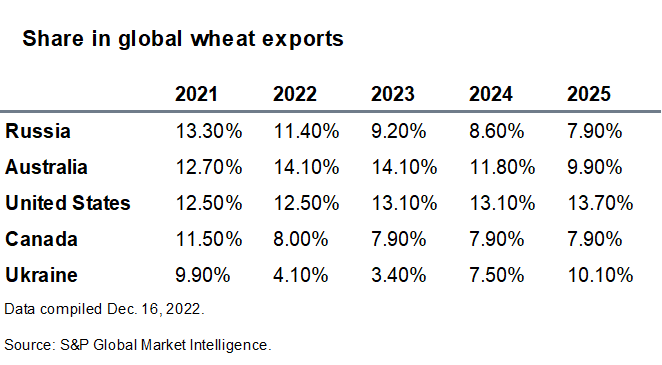S&P Global Offerings
Featured Topics
Featured Products
Events
S&P Global Offerings
Featured Topics
Featured Products
Events
S&P Global Offerings
Featured Topics
Featured Products
Events
Banking & Capital Markets
Economy & Finance
Energy Transition & Sustainability
Technology & Innovation
Podcasts & Newsletters
Banking & Capital Markets
Economy & Finance
Energy Transition & Sustainability
Technology & Innovation
Podcasts & Newsletters
S&P Global Offerings
Featured Topics
Featured Products
Events
BLOG — Jan 23, 2023

By Krzysztof Ziolkowski Sr
The Russia-Ukraine war has had a significant impact on European countries. From the perspective of migration movements, Poland has received about 1.5 million refugees from Ukraine. Heavily dependent on Russian coal, gas, and oil, Europe is facing a major energy crisis. Laboriously rebuilt supply chains after the COVID-19 pandemic have been broken again and must be reorganized. The hostilities in Ukraine have also destabilized the global grain market.
The agriculture market is a specific one as the supply in the market for agricultural products is less flexible than in the case of industrial goods. Manufacturers are unable to respond to large changes in demand or prices, since the flexibility depends mainly on natural factors such as climate, soil, and topography of the region.
In connection with the above, there is monopolistic competition on the grain market and the main producers can influence the price on the world market through a properly conducted trade policy. Currently, because of the Russian invasion of Ukraine, the supply of grains in the world market has been limited, resulting in an increase in the price, hence creating a new equilibrium. Shortage of supply in this market results in food problems in Middle Eastern and North and Sub-Saharan African countries. These problems may lead to further migration movements.
It can be said that Eastern Europe was one of the leaders in grain exports. As a result of the war, Ukraine is unable to start full production because ports and warehouses were destroyed. Supply chains by sea across the Black Sea have also been disrupted. In addition, Russia has reduced grain exports to foreign markets. Russia and Ukraine, apart from a significant share in the global wheat market, are also known for the export of sunflower oil, corn, and barley. These articles require properly prepared storage conditions (which is associated with high costs) and the organization of appropriate distribution. The impact of the war on the grain market is presented below, especially considering the role of Ukraine as the main producer.
The grain market is one of the sectors hit the hardest by the Russian invasion of Ukraine — the two countries together accounted for 23.1% of global wheat exports in 2021. At the same time, Australia and the United States account for 25.3% of global wheat exports. Together these four countries account for half of the world's exports. Our latest forecasts show that by 2025, Russia's exports will decrease and reach 7.9% and this country will lose its first ranking in the list of world exporters of wheat, whereas Ukraine's share in global wheat exports will increase and reach around 10.1%, placing it at the second place. This is of course subject to change, depending on the time and course of the ongoing conflict.
So far, part of the EU wheat production, mainly from France, Germany, Romania, as well as Bulgaria and Poland, has been exported to foreign markets, mainly to countries in Africa and the Middle East. The exports of the above-mentioned countries accounted for 18.9% of world wheat exports in 2021. However, the domestic shortage of other grains makes these countries less likely to export as they need to satisfy the domestic market, and wheat can be a very expensive supplement on the feed market. The main recipients of Ukrainian wheat were Egypt, Indonesia, Turkey, Morocco, and Pakistan, while Russia exported mainly to Turkey, Egypt, Azerbaijan, Kazakhstan, and Nigeria.
Ukraine is the largest European corn exporter and the third in the world after the United States and Argentina. In 2021, corn exports from Ukraine accounted for 11.8% of world exports. It needs to be highlighted here that unlike wheat, the European Union is a net importer of maize, which is essential for feed production. Because of supply chain disruptions, the European Union will have to import maize from the United States, Argentina, and Brazil, which together accounted for 66.4% of world exports in 2021. In general, until 2025 there will be not significant changes on that market. According to the GTAS Forecasting(opens in a new tab) current assumptions, Ukraine should regain its position by that time, but of course there is still a lot of uncertainty about the continuing war and thus the forecast may be subject to change. The main recipients of Ukrainian corn were mainland China, Spain, the Netherlands, Egypt, and Iran in 2021.
Apart from corn and wheat that we already mentioned, we would also like to focus on sunflower with its two main directions of production: cultivation for seeds for direct consumption and oil processing. The sunflower is the fourth-largest crop among oilseeds. The seeds are used to produce food and fodder, while the dried stems and oil can be used to produce biofuels.
Ukraine plays an important role when it comes to sunflower seeds, rapeseed, and colza seeds. It is the main exporter in Europe and the third in the world after Canada and Australia. Ukraine's share in world exports was 11.4% in 2021. Currently, GTAS Forecasting(opens in a new tab) estimation is that the share of Ukraine exports of sunflower seeds, rapeseed, and colza seeds would increase to 5.8% in 2024 from 4.9% in 2023. It should also be noted that owing to Ukraine's geographical location, it was an important exporter of this product to the Middle East and European markets. In addition, numerous mills located in Ukraine produced significant amounts of sunflower oil. The main buyers of Ukrainian sunflower were Germany, Holland, Belgium, Pakistan, and France.
In 2022, the European Union launched the "Solidarity Lanes" initiative for Ukraine, which has allowed for exports of over 15 MMt of grains, oilseeds, and related products (60% of Ukrainian's grain since the start of war). "Solidarity Lanes" is aimed at promoting the export of agricultural products to enable connection between European shippers and producers in Ukraine. The essence of this plan is to support the transport capacity of rail/road/barge vehicles.
According to the Ministry of Agrarian Policy and Food of Ukraine statistics, the following grains were transported in 2022: corn, sunflower seeds, soybean oil, sunflower oil, wheat, turnip, soy, and barley by road (10.9% of total volume), by rail (21.0%), by ferry/barge (0.6%), and by sea (67.5%).
In July 2022, Russia, Ukraine, and Turkey signed the Black Sea Grain Initiative to establish a humanitarian maritime corridor to allow export of grains and fertilizers through the Black Sea from three key Ukrainian ports — Chornomorsk, Odesa, and Yuzhny/Pivdennyi. According to S&P Global Market Intelligence Commodities at Sea, total agricultural bulk export shipments from Ukraine (on vessels above 10,000 DWT) the Black Sea safe passage deal has allowed stood at around 10 MMt of grains and other food.
According to the GTAS data, Ukrainian exports of grains (including wheat and meslin; corn (maize); sunflower seeds, whether or not broken; sunflower seed, safflower, or cottonseed oil, and their fractions, whether or not refined but not chemically modified; and barley) reached 22.5 MMt from March until October 2022. The main recipients of the abovementioned grains were Romania, Turkey, Poland, Spain, Hungary, Italy, Bulgaria, mainland China, and Egypt.
There is hope that land and river transport will develop more because the European Union significantly stimulates the development of the "Solidarity Lanes" so that grain from Ukraine reaches its final recipients, mainly Africa, to avoid further migration waves from this continent and to prevent social unrest.
Learn more about our Global Trade Analytics Suite (GTAS)(opens in a new tab).
This article was published by S&P Global Market Intelligence and not by S&P Global Ratings, which is a separately managed division of S&P Global.
